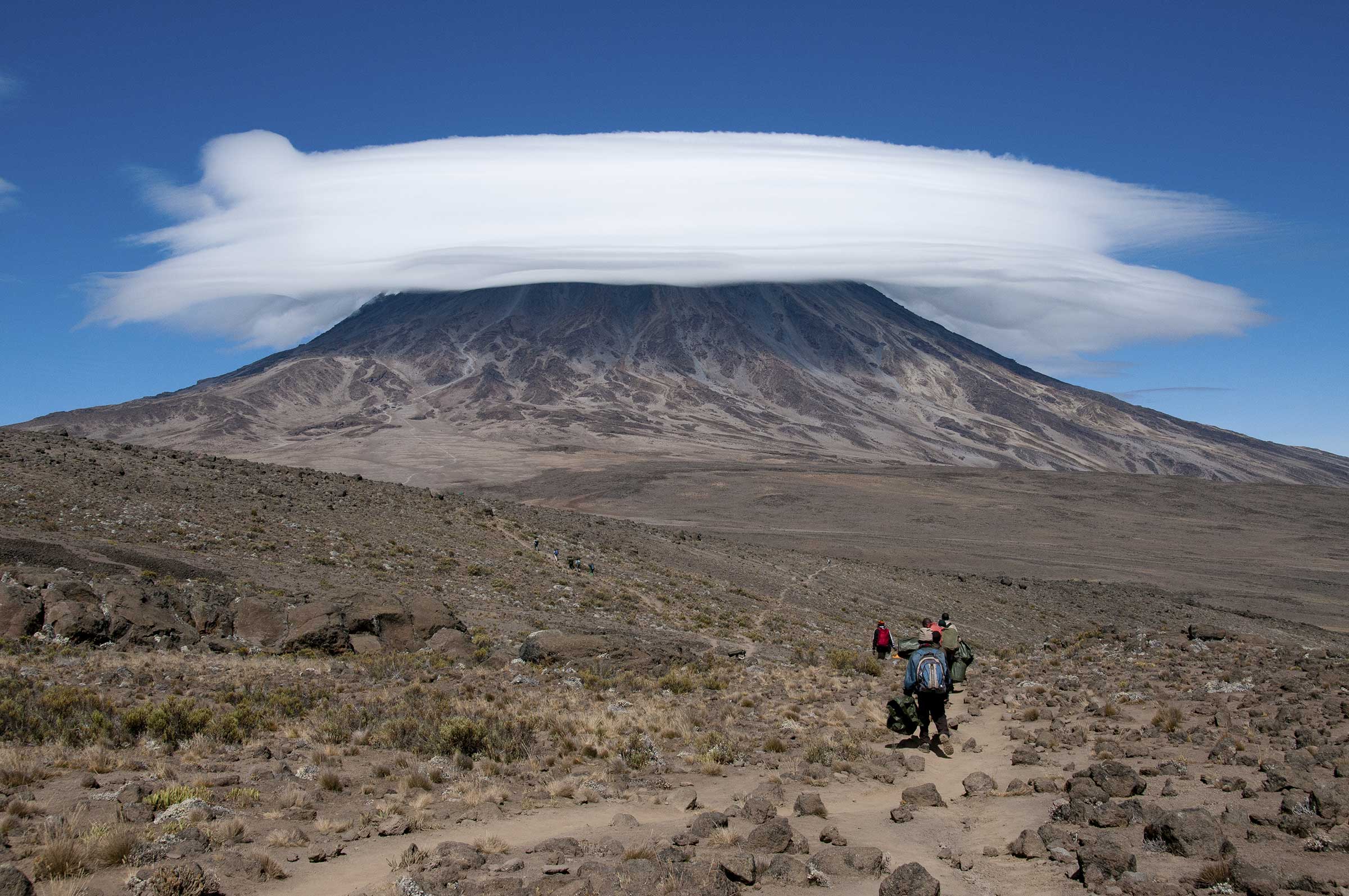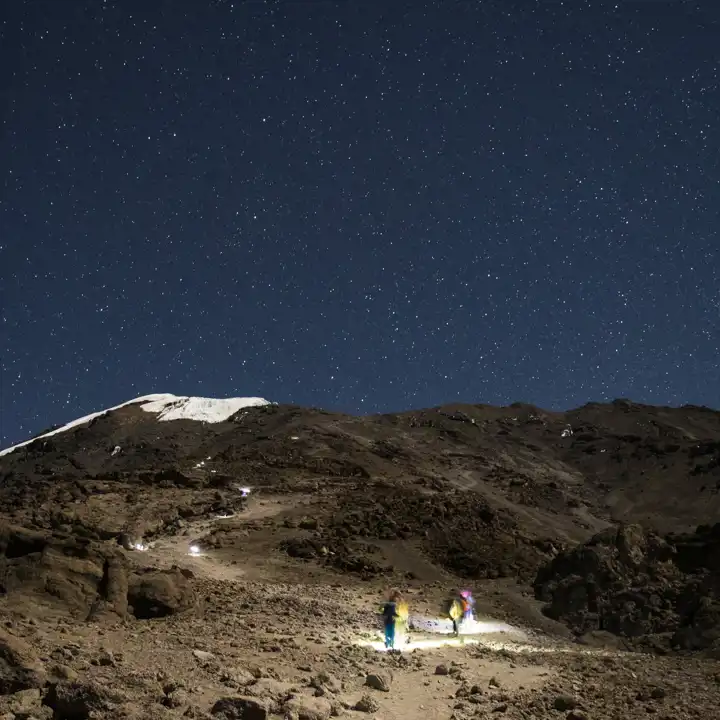Summiting Tanzania's Roof
An Unforgettable Kilimanjaro Climb
Climbing Mount Kilimanjaro
Kilimanjaro: the name itself is shrouded in mystery and magnificence. Mount Kilimanjaro is the largest free-standing mountain in the world and Africa’s highest mountain, with its snow capped Uhuru Peak looming 19,341 feet above the savannah plains like a beacon to nature’s most mind-blowing phenomena. Standing in its presence, it’s not difficult to understand why this epic three-coned stratovolcano—the Rooftop of Africa—has come to represent the compelling beauty of East Africa and a powerful life force for the native people.
Yet there is so much more to a Mount Kilimanjaro climb than reaching her imperious summit. From base to peak, Mount Kilimanjaro encompasses a climatic world tour through five wholly singular ecosystems. Even before crossing into the Kilimanjaro National Park boundary, the lower cultivated foot slopes give way to a beautiful montane forest belt, rich in elusive and endangered wildlife populations, including elephant, leopard, buffalo, colobus monkeys, prolific birdlife, and the endangered Abbot’s duiker. Higher still lies the moorland zone, where a massive cover of heather is studded in giant lobelias. From there, the surreal alpine deserts of moss and lichen are the final vestiges of vegetation before arriving at the summit’s winter wonderland of snow and glacial ice.

While the origins of Kilimanjaro’s moniker remain yet unknown, the name itself has sparked droves of adventurous souls to its slopes. More than 75,000 people climb Kilimanjaro every year, attracted to its less arduous trails and fairly high summit success rate. Despite its accessibility for the average traveler, the mountain remains a considerable feat of human endurance, with approximately five days of pure climbing and less than half the amount of sea level’s breathable oxygen at the top. There are seven official trekking routes to and from Uhuru Point, the highest summit on the crater rim of the topmost Kibo volcanic cone, as well as various other more demanding mountaineering routes. No matter the path, anyone who attempts the behemoth Kili does so with the promise of standing atop the summit of Africa, the overseer of the continent.
Ker & Downey’s Favorite Kilimanjaro Climb
Climbing Mount Kilimanjaro is a bucket list item for many adventure travelers. And rightly so. It’s the highest peak in Africa, yet its summit is very accessible. For some, a walking stick and proper clothing are all that’s required to reach the crater rim. While there are seven official routes to climb Mount Kilimanjaro, there’s one route that is a clear favorite for Ker & Downey clients. For a well-rounded adventure, ascend the mountain on the Rongai Route and return on the popular Marangu Route.
The Rongai Route
With its gentle gradient and unspoiled remoteness, the Rongai Route is the only trail that summits Mount Kilimanjaro from the north, near the Kenyan border. This beautiful seven-day small group Kilimanjaro guided climb through farmlands, forest, and alpine moorlands is one of the lowest traffic routes on Kili and perfect for those looking to ascend the mighty Roof of Africa without hassle of crowds and with the added luxuries of dedicated guides, cooks, and porters.
The Rongai Route up Mount Kilimanjaro begins on the Eastern side of the mountain along the base of Mawenzi. Even before one crosses into the national park boundary, these foothills give way to a lush alpine forest where elusive populations of elephant, leopard, buffalo, the endangered Abbot’s duiker, and other wildlife can sometimes be seen. Birdlife is prolific along the Rongai Route, as are the colobus monkeys—a unique highlight of this particular climb. Ascending via Gillman’s Point to Uhuru Peak, the moorlands of giant heather and lobelias transform into a surreal alpine desert of moss and lichen. The final vestige of vegetation eventually gives way to a winter wonderland of glacial ice and snow as the summit approaches. Views over the Mwaenzi and Kibo saddle, close vantages of Mawenzi, the Kibo Crater, glaciers, and most importantly, the Roof of Africa can be expected on every unforgettable climb.

The seven-day climb along the Rongai Route allows for an extra day of acclimatization under the spires of Mawenzi Tarn before the last arduous ascent, which promises incomparable sunrise vistas over the East African plains. Upon reaching the summit, climbers will descend via the Marangu route.
Accommodations Along the Rongai Route
During the climb, trekkers will stay two nights in comfortable Arusha lodgings and five nights in full-service alpine camping areas in three-man tents with private toilet tents. A large communal tent allows for dining and socialization during days of leisurely acclimatization and comes with lightweight tables, chairs, and all cutleries. The trek is fully supported with spacious guest tents, mattresses, and pillows and catered to by dedicated mountain guides, local representatives, cooks, and porters.

A Kilimanjaro Climb by Ker & Downey
Summit Mount Kilimanjaro along the Rongai Route, camping lakeside and enjoying multiple ecosystems and fully-catered meals along the way, ultimately celebrating your post-Kilimanjaro conquer with several relaxing days in the Serengeti.
Explore the Itinerary
Talk to A Travel Designer
Get advice and suggestions to make this your perfect trip.
Or give us a call at 800.423.4236.
Inquire NowSee What We Are Up To
Subscribe to our Weekly Newsletter for Travel Tips and Insider Guides for Planning your Next Journey!
